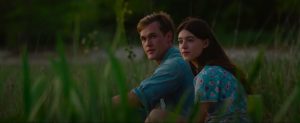PERHAPS I should have done a little more homework in preparation for watching Where the Crawdads Sing.
I knew it was based on a best-selling novel, was set in the backwaters of North Carolina in the 1960s and involved a murder trial.
That was enough for me and it was one of those trailers that I chose not to watch, less it ruin my full enjoyment of the film.
What I didn’t realise is that the relationship drama which consumes an equal part of the running time is not much better than a Mills and Boon treatment and consequently lessens the dramatic impact. I expected a better showing from Lucy Alibar who previously wrote the screenplay for Beasts of the Southern Wild.
The court room scenes are the best part of the film, mainly due to the they showcase the acting ability of David Strathairn who plays the defence lawyer.
I’ll back-track a little.
The film is set in the marshy country along the North Carolina coast starting in the 1950s when the heroine, Catherine ‘Kya’ Clark, is a young girl growing up in a large family dominated by an abusive, alcoholic father.
Through a series of circumstances Kya, played well by English actress Daisy Edgar-Jones, is left completely alone in the family home at age seven and has to learn to survive, farming and selling mussels to a local store. Most of the residents of the nearby town of Barkley Cove shun the wild-looking urchin whom they nickname ‘The Marsh Girl’.
The exceptions are the couple who own the local store and lawyer Tom Milton (Strathairn) who occasionally encounters her on the street.
We move to the 1960s and Kya is befriended by local boy Tate Walker (Taylor John Smith) who teaches her how to read and encourages her drawing talent. Eventually Tate leaves the area for college and Kya is slowly drawn into a relationship with Chase Andrews (Harris Dickinson), a popular local footballer whom we know is trouble from the moment he appears.
Spoilers aside, Kya is charged with a murder and Milton comes out of retirement to defend her, knowing the jury will be comprised of townspeople and their prejudices will act against Kya getting a fair hearing.
It’s a picturesque location but the direction and photography never truly make it come alive as a character, which I suspect it is meant to do. While the mystery surrounding the murder is interesting, the resolution of the court case is not handled particularly
well with several logistical hurdles to contend with.
It’s a decent romantic/drama but not the captivating experience I was hoping for.
